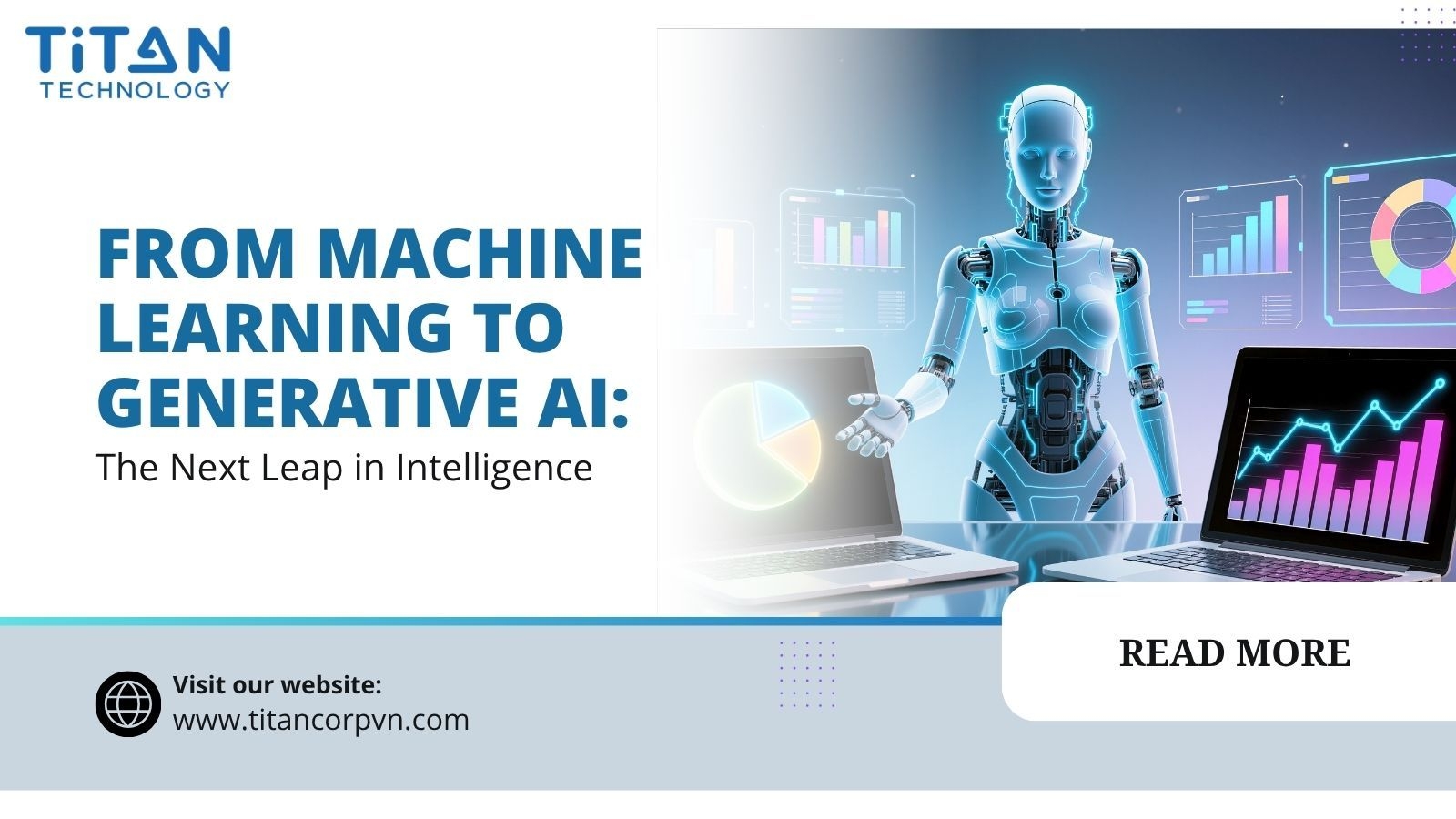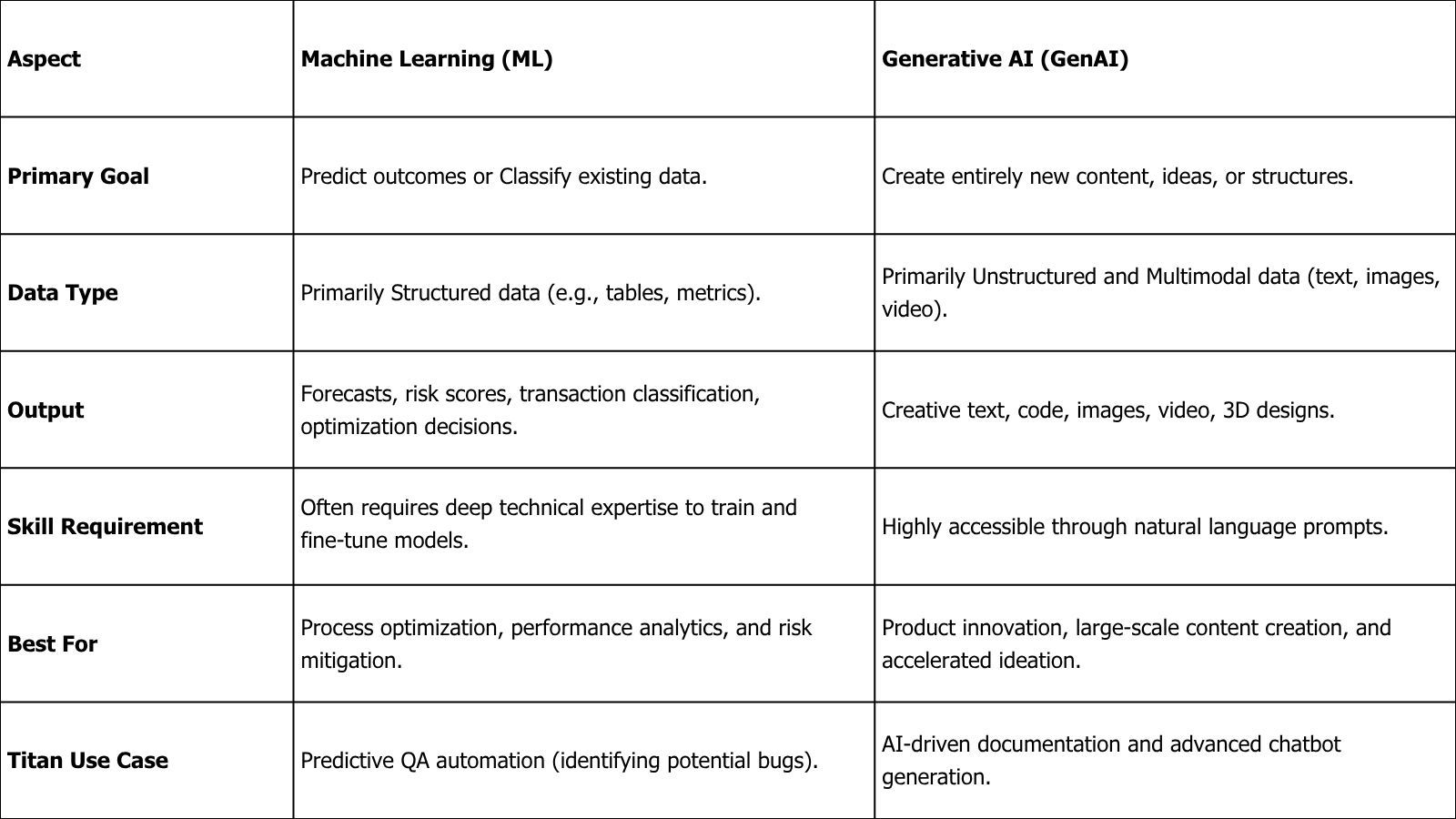Summary
AI is projected to add $15.7 trillion to the global economy by 2030, reshaping how enterprises innovate and compete.
The evolution spans from rule-based systems → Machine Learning (predictive) → Generative AI (creative).
Machine Learning powers prediction and optimization, while Generative AI drives content creation and innovation.
The next frontier is hybrid intelligence, combining ML’s analytics with GenAI’s creativity for smarter decision-making.
Success in AI transformation depends on responsible design, transparency, and governance to build trust and long-term value.

Artificial Intelligence (AI) is no longer a futuristic concept; it is a multi-trillion-dollar economic force. According to studies from McKinsey and PwC, AI is projected to reshape nearly every industry, with the potential to add $15.7 trillion to the global economy by 2030.
However, for founders and managers, translating these impressive figures into practical business strategies is often blocked by a major language barrier: AI, Machine Learning (ML), and Generative AI (GenAI) are frequently used interchangeably. This confusion obscures which technologies are truly driving tangible business value.
This article is designed to demystify these terms. We will simplify how these technologies connect, differ, and, most importantly, how they shape modern business values. Titan’s goal is to provide you with the clarity you need to move AI from a buzzword to a strategic asset.
What Is Artificial Intelligence?
At its most fundamental level, Artificial Intelligence (AI) is a field of computer science dedicated to creating systems that can mimic human intelligence to perform complex tasks. Unlike traditional software that follows fixed commands, AI systems can learn from data, reason through problems, and make decisions in dynamic environments.
A Brief Historical Arc
AI has evolved through several distinct phases that reflect how machines have grown from rule followers to creative thinkers:
Rule-Based Systems: Early AI systems operated on pre-defined "IF-THEN" rule sets programmed by humans. They were only as smart as the rules they were given and couldn't learn from new data.
Machine Learning (ML): The real revolution came when computers began to learn from examples instead of explicit programming. ML became the foundation of modern AI, powering applications that predict outcomes and recognize patterns.
Generative AI (GenAI): The next evolution of AI extends beyond prediction to creation. GenAI systems can produce new content such as text, images, code, or even business strategies based on learned patterns.
Real-World Touchpoints
AI is now deeply woven into everyday business and personal experiences, often referred to as “ambient intelligence.”
Voice Assistants: Tools like Siri or Alexa understand and respond to natural speech.
Recommendation Engines: Platforms such as Netflix and Amazon analyze preferences to deliver personalized content or product suggestions.
Fraud Detection: Financial institutions use ML models to spot unusual transactions in real time.
For more formal definitions and frameworks, refer to the OECD AI glossary. To see how these principles are applied in practice, explore Titan’s Artificial Intelligence Solutions and discover how data-driven systems can enhance performance, security, and scalability.
Machine Learning: The Predictive Engine
If Artificial Intelligence (AI) is the brain, Machine Learning (ML) is its predictive engine. ML is the core discipline of AI that enables systems to automatically learn and improve from experience without being explicitly programmed. According to Statista, the global machine learning market is projected to exceed USD 200 billion by 2029, confirming its vital role in enterprise innovation.
By recognizing complex patterns in large datasets, ML helps businesses make accurate, data-driven decisions with higher confidence.
The Core Principle: Learning from Examples
Unlike traditional software that follows fixed rules, ML algorithms use statistical methods to learn from examples. The system is trained on extensive datasets such as thousands of images labeled “cat” or “not cat.” From these examples, it can independently determine the patterns and relationships needed to classify new and unseen data accurately.
This learning process can be grouped into three main techniques:

Delivering Business Value Through Prediction
For managers and founders, ML provides a direct path to operational efficiency and risk reduction.
Finance: Algorithms analyze transaction data and behavioral patterns to detect fraud in real time before losses occur.
Logistics: ML models use historical sales, seasonal data, and external factors like weather to forecast demand accurately, reducing storage costs, and avoiding stock shortages.
Manufacturing: Data from sensors on equipment helps ML systems predict when components might fail. This approach, known as predictive maintenance, minimizes downtime and prevents costly production interruptions.
Machine learning remains the foundational layer of modern AI strategies, powering predictive insights that help organizations achieve measurable and sustainable results. While ML focuses on prediction and optimization, the next step in the AI journey, Generative AI (GenAI), introduces a completely new dimension: creativity and innovation to intelligent systems.
Generative AI: The Creative Frontier
If Machine Learning is the engine for prediction and optimization, Generative AI (GenAI) is the catalyst for creation and innovation. It marks a significant leap, shifting the focus of artificial intelligence from merely analyzing existing data to creating new value.
Generative AI builds directly on ML foundations but focuses on creating entirely new outputs such as text, code, design mockups, audio, or even complex business strategies. These systems learn the underlying structure and context of massive, unstructured datasets and apply that understanding to generate novel content that often mirrors human creativity and nuance.
The GenAI boom is undeniable: According to McKinsey’s 2024 State of AI Report, more than 70 percent of global enterprises are now testing or implementing GenAI tools to enhance productivity and innovation.
Key Model Types (Simplified)
GenAI’s creative capability is powered by advanced model architectures:
Large Language Models (LLMs): Specialize in understanding, summarizing, and generating human-like text and code (for example, GPT-4 or Llama).
Diffusion Models: Generate highly realistic images or videos based on simple text instructions (for example, Midjourney or DALL·E).
Multimodal AI: Systems that combine text, visuals, and data to generate content across multiple formats, such as producing functional code from a design sketch.
Benefits for Business Leaders
Generative AI offers immediate and measurable gains in efficiency and competitive advantage:
Faster Ideation and Automation: It can draft marketing copy, summarize long reports, or generate code snippets within seconds, dramatically reducing workloads and boosting the creative cycle.
Human-like Understanding: Its ability to process natural language makes interaction intuitive and highly accessible for non-technical teams.
Lower Barrier to AI Adoption: Unlike traditional ML, which often requires specialized data scientists to train models, GenAI tools enable broader usage across departments with minimal technical expertise.
Field Examples in Practice
Marketing Automation: GenAI can analyze thousands of customer reviews to instantly summarize insights and recommend relevant campaign themes.
HR Onboarding: AI assistants powered by LLMs can accurately and instantly answer policy questions and complete administrative tasks, freeing up valuable HR capacity.
Generative AI empowers organizations to scale creativity, automate reasoning, and expand innovation potential.
Machine Learning vs. Generative AI: Key Differences
To deploy AI strategically, leaders must grasp the core differences between Machine Learning (ML) and Generative AI (GenAI) in terms of purpose, data input, and output results. In fact, businesses leveraging both technologies are outperforming. Enterprises combining predictive and generative models can outperform those using either technology alone by a significant margin in terms of overall performance and innovation velocity.

Insight: Synergy, Not Substitution
The most critical message is that Generative AI does not replace Machine Learning. Instead, GenAI amplifies ML’s predictive insights with creative intelligence. The two technologies operate symbiotically:
ML provides structured data and precise predictions, serving as the analytical base.
GenAI transforms those predictions into synthesized reports, personalized content, and actionable strategic recommendations.
Together, they form an intelligent feedback loop that automates both analytical and creative tasks. This frees teams from repetitive work and allows them to focus more on strategic innovation. This collaborative intelligence sets the foundation for responsible, transparent, and human-aligned AI systems, a topic we will explore further through practical examples.
How Businesses Use AI in 2025
Artificial Intelligence is no longer a side experiment. In 2025, it has become the connective tissue of modern enterprises. The most forward-thinking organizations are no longer asking whether to use AI, but how to combine Machine Learning (ML) and Generative AI (GenAI) into one unified system that drives measurable results.
This next wave is called hybrid intelligence—a model where prediction and creation coexist in a continuous feedback loop. ML extracts insight from data. GenAI transforms those insights into decisions, designs, or narratives. Together, they accelerate innovation cycles, shorten decision-making time, and unlock entirely new value streams across industries.
Below are practical examples of how hybrid AI is already redefining performance and creativity in key sectors:
Finance: From Detection to Reporting
Machine Learning’s Role (Prediction): ML systems continuously monitor billions of transactions, customer histories, and behavioral signals to identify anomalies and assess risk in real time.
Generative AI’s Role (Creation): GenAI models instantly turn those ML outputs into structured, plain-language summaries and compliance reports. This reduces manual reporting workloads by over 60 percent in some enterprise implementations.
Healthcare: From Diagnosis to Personalized Care
Machine Learning’s Role (Prediction): Predictive models analyze patient data, genetic profiles, and medical history to identify potential health risks or treatment responses.
Generative AI’s Role (Creation): Clinicians use GenAI-powered assistants to convert predictive scores into personalized treatment plans and easy-to-understand communication, improving both patient trust and care outcomes.
Retail & E-Commerce: From Optimization to Content
Machine Learning’s Role (Optimization): ML analyzes sales velocity, demand fluctuations, and logistics data to fine-tune pricing, promotions, and inventory management.
Generative AI’s Role (Creation): GenAI turns these insights into creative content, writing product descriptions, generating ad copy, and producing visual mockups that align with brand voice and customer intent.
These real-world applications show that AI innovation thrives at the intersection of data and creativity. Businesses that master this balance can move from reactive decision-making to proactive strategy shaping.
As AI becomes embedded in every layer of enterprise operations, a new question emerges: how can organizations innovate at speed without sacrificing security, transparency, or ethical accountability? The next section explores how responsible AI governance ensures innovation remains safe, compliant, and sustainable.
Responsible and Transparent AI
Artificial Intelligence offers remarkable opportunities, but its long-term success depends on trust. As AI becomes deeply integrated into enterprise operations, ensuring that systems are secure, transparent, and ethically governed has become essential. The organizations that embed responsibility into their design principles are the ones shaping the future of intelligent business.
1. Security: Protecting Data, Systems, and People
Every AI system begins with data, and protecting that data is fundamental to responsible innovation. Titan complies with ISO 27001:2022 to safeguard information across all environments. Strong access controls, continuous monitoring, and encryption standards are applied to ensure that sensitive business and user data remain protected at all times.
Titan’s approach extends beyond compliance. The company designs systems for resilience, enabling rapid detection and recovery from cyber incidents. This proactive mindset reduces operational risk and strengthens long-term client confidence.
2. Transparency: Making AI Explainable and Accountable
Trust requires clarity. Titan ensures that each model can explain how it reaches conclusions and what data influences its output. The team maintains clear documentation of data sources, training logic, and decision parameters so that clients can trace and validate every result.
This focus on explainability turns AI from a black box into a transparent, collaborative system that supports informed human decision-making. It also reinforces regulatory alignment and ethical accountability.
3. Governance: Embedding Ethics into AI Design
Responsible AI cannot exist without governance that aligns technology with human values. Titan’s governance practices follow the NIST AI Risk Management Framework, emphasizing fairness, accountability, and reliability across every phase of model development.
Each deployment includes bias detection, fairness reviews, and human oversight to ensure outcomes remain balanced and socially responsible. Governance is not only about minimizing risk; it is about designing AI that reflects integrity and respect for its users.
Building a Culture of Responsible Innovation
At Titan, responsibility is not an add-on. It is part of the company’s identity and engineering culture. Every AI initiative is built on the belief that technology must serve people and society. From predictive analytics to generative systems, Titan integrates ethics, transparency, and security into every layer of development.
This philosophy allows enterprises to innovate with confidence while maintaining compliance, privacy, and trust. It is how Titan redefines what progress means in the age of artificial intelligence: advancing not only technology but also accountability and human values.
Conclusion: Building a Smarter, Safer AI Future
The age of AI is defined by transformation, not experimentation. This guide has explored the powerful, symbiotic roles of Machine Learning (prediction) and Generative AI (creation), showing that true value comes from their integration into hybrid intelligence ecosystems.
For leaders, the real strategic goal isn't adoption; it's responsible design. True innovation emerges from systems that are transparent, trustworthy, and aligned with human intent.
This is Titan’s core philosophy: Technology should empower people, not replace them. We believe the future of AI isn't simply about smarter systems; it's about safer, more human-centered intelligence that builds lasting trust.
From Insight to Action: Innovate with Integrity
To harness hybrid intelligence effectively, start by identifying where prediction and creation can generate measurable, sustainable value within your organization. Collaborate with partners who prioritize security, transparency, and ethical governance in every stage of AI design.
Contact us to explore how Titan’s artificial intelligence solutions can help your enterprise design intelligent systems that are secure, transparent, and built to last.



